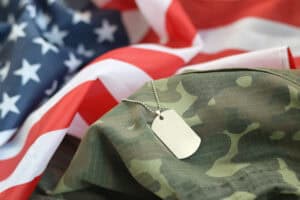
When the Veterans of Foreign Wars gathered last month for its national convention, Christine Pawley of Post 7448 in Winthrop Harbor, Ill., stepped to a microphone.
“Comrades,” she said, “it’s time for change.”
Pawley is 40, a Navy veteran of the Kosovo campaign. Filling the cavernous St. Louis arena in which Pawley stood were thousands of aging veterans of the more epic conflicts getting around with walkers, canes or electric scooters.
The scene said it all. The venerable VFW, headquartered more than eight decades in Kansas City, is struggling to stay relevant in the 21st century.
Membership has been sinking 22 years straight, even as recent foreign wars have made millions eligible to join.
Veterans of the fighting in Iraq and Afghanistan have been slow to sign up at their local posts to attend meetings and don the colorful caps of an organization absorbed in tradition.
Consider Pawley’s plea: Isn’t it time to undo the Ladies Auxiliary?
The Ladies Auxiliary, also headquartered in Kansas City, is a popular VFW offshoot dating to 1914. Formed to provide a service and charity outlet for wives, mothers and daughters of fighting men, today it seems to Pawley and others a relic.
From the VFW executive offices at Broadway and Linwood, assistant adjutant general Jerry Newberry said the Ladies Auxiliary debate has been going for years. And it goes to an aspect of the VFW that both hinders and helps the organization’s allure.
“This love of tradition,” Newberry said. “A lot of us think, really? But you got many out there who love it. They love the traditions.”
Yet the younger-than-40 veterans aren’t piling in.
To them, the traditions of the VFW include sitting in a smoky post canteen, jawing over whose war was worse. Or wearing those caps at monthly meetings that begin and end with prayer.
That’s what Grandpa did, at least, on nights when bingo wasn’t the featured draw.
VFW’s national officers say the priority at most posts is to help fellow veterans — of any war. And to educate the young. Gray-headed members especially delight in visiting classrooms and awarding scholarships to students who author patriotic essays.
But the organization’s mightiest enemy, most agree, is that smelly-bar image, stoked over the years by posts that had popped up in almost every American locale.
It’s why hundreds of posts have closed or consolidated in the last decade, unable to appeal to young veterans with families.
So why not fix it?
VFW National says it’s trying. Problem is, “we don’t tell the posts what to do,” said Richard Kolb, publisher of the Kansas City-based VFW magazine. “We can’t force them to do anything …
“We still have a few diehard groups out there, to this day, who aren’t concerned about adding younger members.”
Today the Vietnam veterans rule. At the 2013 convention, VFW’s then-commander in chief, William Thien, pronounced: “Comrades, Vietnam veterans have a tight hold on the operation of this organization at every level.
“If we don’t loosen our grip and give the younger folks free rein,” said Thien, himself of the era, “we are going to choke off their participation.”
In his Kansas City office, Kolb paused at his desk when asked what worried him most.
“My biggest concern is relevancy,” said Kolb, who is 64. “Are we going to be relevant to future generations of war veterans?”
Some say VFW National isn’t working with enough urgency to address that question, though it should.
And very soon.
With membership at 1.3 million — down from its 1992 peak of 2.1 million — the average age is almost 70.
What’s needed is “an infusion of new blood immediately … or the VFW will cease to exist,” newly installed commander in chief John Stroud told the convention.
He called on the 6,500 posts that remain to “create a healthier atmosphere” and be more family friendly.
VFW National faces other obstacles. In the last decade, fresh veterans service groups have sprung like poppies. They provide new options not just for returning warriors but also for a public wishing to donate to veterans’ causes. Philanthropy experts say the VFW spends too much on fundraising.
Urging change now, Pawley took her best shot at the mic.
The Ladies Auxiliary does good work, she said, but “why can’t my son choose to join?” Many posts have Men’s Auxiliaries for eligible veterans’ loved ones, though Pawley is among VFWers young and old pushing a simpler solution:
Just the “Auxiliary,” specific to no gender and recognized nationally.
By a voice vote, the convention struck down her proposal, which lacks support from the Ladies Auxiliary itself.
But delegates did move to delete words such as “men” and “widows” from VFW’s congressional charter. And headquarters soon will draft bylaws for a gender-neutral auxiliary to be considered at next year’s convention.
“We know we have to change with the world,” Newberry said.
Bottoms up
The watering-hole image that VFW National is trying to shake is in many places already obsolete.
Posts today commonly can’t afford their own buildings, let alone the employees needed to run a tavern. So dedicated members meet in public libraries and community centers.
At Post 5717 in Kearney, however, it’s still bottoms up.
Amid red Budweiser signs saluting the VFW, three Smokeeters whir to filter the tobacco haze around the bar.
Only two other drinking joints exist in town. And because Missouri law allows the post to serve adults who aren’t VFW members, on a typical night most of them aren’t.
(In Kansas and other states, membership is required to drink alcohol at post canteens. “Guests” of VFW members may also imbibe.)
“If the national organization had its way, there wouldn’t be any bars,” said 5717 commander and Vietnam veteran Jim Holmes. “Ninety percent of the VFW’s problems involve something bad that happened in a bar.”
His post acquired and renovated Kearney’s old train depot to house the pub and an adjoining breakfast area/meeting room.
The clientele at the bar is older, agreeable, no fights. Holmes attributed that to the absence of young adults stirring up things besides drinks.
“Our people come in and don’t really want to be around a bunch of younger kids, and the young people probably don’t want to be around us,” he said.
The same goes for young veterans who choose not to join the post and take part in its charity efforts.
Donating to the Scouts. Sponsoring scholarships through the VFW’s Patriot Pen and Voice of Democracy essays at schools. Hosting free meals for senior citizens.
And, most important, serving other veterans. Holmes has driven struggling Iraq veterans to Kansas City so they can get help from social services or Veterans Affairs.
He might never see them again.
“The younger generation, they’re really not joiners. They’ve got families, they might be going to college, starting out careers,” said Holmes, 63. “They don’t want to join a group if they don’t have time to participate.”
He was that way 40 years ago when he joined the VFW and let his membership lapse.
But it’s odd to assume younger veterans aren’t joiners, said veteran Kyle Ulrey, 37. After all, they joined the military.
There is a different flavor, though, to the community of young veterans, said Ulrey, of Olathe.
“For us, it’s to get out and be active,” he said. “To be engaged, have a mission and purpose.”
The purpose of the VFW is hard to dismiss. Beyond the local parades, the scholarship programs and assistance to needy veterans, a GI education bill more generous than ever came out of Washington in 2009 after intense VFW lobbying that predated the war on terror.
Ulrey, however, is regional logistics officer for a new kind of veterans group, a nongovernmental organization called Team Rubicon. Its mission is to unite military veterans with first responders to hurry emergency teams into disaster areas.
Formed by two Marine veterans after the 2010 Haiti earthquake, thousands of volunteers have since rushed to catastrophes in Pakistan, Chili and Sudan, delivering medicine and helping with reconstruction.
“This is all grown through social media,” Ulrey said. Unlike the VFW, “we don’t hold meetings. Don’t get together for conventions.
“We do emails. We do tweets. Facebook. We use technology to our advantage and push the word out.”
In the Kansas City region, Team Rubicon volunteers already have responded to five tornado sites this year, including Baxter Springs, Kan., where they tarped roofs and scooped muck from basements.
Rubicon’s staging area there?
The VFW hall for Post 408.
It was great to have the building, even if the post hasn’t got a website.
Locked museum
Did you know there’s a museum at the VFW headquarters on Broadway?
It’s usually locked up. A guest book shows fewer than three dozen signatures so far this year.
Inside the museum, a framed page from a 1923 edition of Foreign Service, then the name of the VFW’s magazine, spelled out how the organization settled here.
A VFW convention in Norfolk, Va., had its pick of four cities — New York, Minneapolis, Detroit and Kansas City, Kan. — from which to grow a national presence.
KCK got 246 votes to New York’s 162. The framed article explained:
“The city is conveniently located, communicating with all parts of the country equally, and this point alone was a strong influence.”
With more than 30 rail lines converging in the area, “a centrally located National Headquarters could … build up the VFW through those parts of the West where it seems weakest.”
Also at the time, a city-owned gem under construction — KCK’s Memorial Building — would provide its top floor for an annual rent of $1.
In 1930, following a spat with KCK over user fees, the VFW jumped the state line and moved its national offices to larger digs in the 12-story Missouri building.
It’s where the national headquarters remains. VFW owns the whole block.
And did you know the headquarters even was here?
Said William Worley, author and teacher of area history: “I know where the building is, but that is the sum total.”
VFW headquarters did help raise more than $300,000 toward expanding the World War I Museum at Liberty Memorial.
But other than that, Worley said, “I’m trying to recall any time they’ve weighed in on anything related to Kansas City. They’re an interesting yet very quiet part of the city’s civic history.
“Kind of sad. The VFW here just doesn’t stand out.”
National executives at VFW aren’t sure how to raise the group’s local profile, or whether they need to.
News releases they send out to local media often do not get reported.
“Maybe we haven’t tooted our horn loud enough,” said assistant adjutant general Newberry, “but is that the correct thing to do when performing benevolent work?”
To be too supportive of the civic goings-on in Kansas City might signal that VFW National cares less about “the VFW folks in Iowa or any other state,” he said.
In Indianapolis — home to the American Legion, a larger veterans group also facing membership declines — officials say a similar disconnect exists within civic life.
“I’d like to say the public knows we’re headquartered here, but that’s not the case,” said American Legion spokesman Joe March.
In any event, VFW National welcomed The Star’s request to spend some time.
About 150 people work there.
A half dozen put out the monthly magazine.
They’ve done several cover stories this year aimed at the under-40 veteran, including one on traumatic brain injury.
“As we should,” said editor Kolb. “We’ve told the story of World War II until we’re blue in the face.”
On the ninth floor is Air Force veteran Kevin C. Jones, director of VFW programs. Jones explained some of the charitable services the VFW has created to help warriors of more recent conflicts.
The Unmet Needs program. Launched in 2004 by the VFW Foundation, it has provided $5 million in help to active service members and the recently discharged. The money goes toward basic needs such as food, utilities and housing.
VFW support built 400 Internet cafes for troops in Iraq and Afghanistan, allowing for 7.5 million Internet connections between warriors and loved ones since 2006.
This month, with the help of a Sport Clips Help a Hero haircut promotion, VFW awarded fall scholarships of as much as $5,000 to 93 veterans.
Near Jones’ office, VFW deputy director Rick Butler examines membership demographics and recognizes a pattern that spans generations.
After any war, veterans are slow to sign up and get involved.
They were slow after the Big One (World War II), after Korea and especially after Vietnam. But as they aged and found time to devote to a post, the VFW historically got at least 10 percent on its rolls.
Butler sees no reason to think the 3 million veterans of Iraq and Afghanistan won’t eventually fall in, though only an estimated 130,000 have so far.
Not even those sign-ups are enough to offset membership losses, due mostly to the deaths of World War II and Korea veterans — as many as 50,000 annually.
Despite post-9/11 conflicts, Butler said, “the bucket we’re picking fish out of is getting smaller.”
Raising funds
The problem facing VFW National is how to keep its coffers full, which it seems to do. It’s a nearly $100 million-a-year operation.
Each post sets the overall dues, roughly $30 or $40 per member for the year. Out of that, $21.50 goes to headquarters.
Still, dues constitute less than 10 percent of VFW National’s income. Most of the rest comes by way of special gifts from members and donations from the public.
Gifts and contributions totaled more than $69 million in fiscal year 2012, according to the national organization’s tax records.
(That’s not counting the incalculable money for charity raised by the posts, each of which files its own tax records, or donations to affiliates such as the VFW Foundation.)
Being what the Internal Revenue Service calls a 501(c)19, or a nonprofit composed mostly of war veterans, VFW National pays no federal income tax on gifts.
It spends a bunch, however, to get them.
Way too much, say some charity watchdogs.
VFW National reported spending close to $30 million on fundraising in 2012, the latest year for which tax records are available. To raise $100, on average, it spent more than $40 on phone solicitations and direct mailings. Brickmill Marketing Services in New Hampshire contracted for direct mailings.
This has stirred criticism from Forbes magazine, among others.
The magazine in 2010 said the most efficient charities among the nation’s 200 largest spent $10 or less to raise $100.
“We long have recommended a harsh look” at charities that spend $30 or more, Forbes advised.
It ranked VFW National’s “fundraising efficiency” near the bottom — between the Girl Scouts and the last-place nonprofit, a New York City public TV station.
“Our concern is simple,” said Daniel Borochoff, president of the nonprofit group CharityWatch, which gives VFA National an F for its fundraising practices.
“They’re not spending money the way most donors would want it spent, which is for programs benefiting veterans. They’re spending it on direct mail and other solicitations.”
VFW National’s Newberry chafes at the criticism.
The watchdogs’ scorecards don’t factor in some $3 billion in yearly VA benefits that he said the VFW network helps veterans recover at hospitals, Vet Centers and schools of higher learning.
But he acknowledged that VFW National needs to rein in its fundraising costs. For large charities, costly direct mailings are a “fact of life,” Newberry said, but what are the alternatives? Many of the organization’s oldest supporters don’t go online to hit the “contribute” link on the VFW website.
Groups that examine nonprofits also question the crowded governing body of VFW National.
Tax records report 65 voting members, mostly volunteers elected to four-year terms by each state and at VFW departments overseas.
This year, only one is a woman.
“Obviously, we’d like to see more,” said magazine editor Kolb. “We’ve been pushing that for years.”
VFW executives say female leadership at the national level is bound to swell as women move up the ranks in their state organizations. In Vermont and Kentucky, women hold the top command.
“We are few and far between,” said Pawley, of Winthrop Harbor, who is senior vice commander at her post.
Beyond its overwhelming maleness, to have 65 voting members on the governing board — called the National Council of Administration — sounds like a lot to Vernetta Walker, a vice president for the nonprofit consulting group BoardSource.
A 2010 survey that BoardSource conducted of 1,750 nonprofit leaders found that the most effective boards have a “sweet spot” of 15 to 20 voting members.
Much more than that gets “too unwieldy,” Walker said.
The council also approves VFW executive pay.
In 2012 the organization reported six-figure salaries to 13 executives, not all of them working out of Kansas City. The highest reported sum, about $255,000, went to quartermaster general Robert Greene. More than $86,000 of that was a pension benefit that had accrued for 36 years.
Forbes reports that average pay for the top executive at large nonprofits nationwide exceeds $600,000.
A recent paper by a Rockhurst University business administration student compared the VFW to an “oligarchy” and questioned its wide-net fundraising — casting for a jillion tiny contributions rather than targeting big donors.
“The organization needs to strategically adapt and change its culture,” wrote John G. Lowe, past director of the VFW Foundation.
Proud to be a century old, “its patterns of doing business,” he wrote, “are often entrenched with a … ‘the way it’s always been done’ mentality.”
War stories
After years of hesitation, many among the Vietnam generation came around to supporting the VFW.
“To be honest, at first I just wanted the cheap beer,” said Dan J. Farley, 68, who before retiring had little time to get involved at Post 10804 in South Carolina. “Now I tell people the purpose of the VFW is pretty simple.
“Veterans helping veterans.”
That was the motivation, as well, for Doug Simms to join Post 10552 in Shawnee. He’s 42.
In Iraq, he said, “I was around burning trash. I’ve been in firefights. The last thing I want is to come home and be in a room filled with smoke.”
Simms belongs to one of the growing number of posts that don’t have a bar. Post 10552 meets in the Shawnee Community Center.
Values change with each generation. Today’s VFW is aware of that.
Newberry said posts will need to reach out and evolve to the tastes of millennials and Gen Xers. The VFW posts that don’t are destined, as some have said of old soldiers, to just fade away.
“Posts that ‘get it’ will thrive,” Newberry predicted. “Those that don’t will go by the wayside.”
To reach Rick Montgomery, call 816-234-4410 or send email to rmontgomery@kcstar.com.
Timeline
In coming weeks the Veterans of Foreign Wars will observe the 100th anniversary of its first national convention. Here’s how the organization has evolved.
1910s:
Spreading from Spanish-American war comrades first organized in 1899, veterans posts from three states meet at a 1914 “encampment” in Pittsburgh. They name the VFW and form a Ladies Auxiliary. Ex-president Teddy Roosevelt becomes the first of eight U.S. presidents to join the VFW.
1920s:
VFW distributes Buddy Poppies, made by disabled World War I veterans to raise funds. The VFW National Home for orphans opens in Michigan.
1930s:
With headquarters established in Kansas City, VFW successfully campaigns for a national anthem, “The Star-Spangled Banner.”
1940s:
Membership swells in World War II, when the VFW helps win passage of the GI Bill. After the war, the organization turns to social pursuits aimed at young families. A VFW marbles tournament launched in 1947 becomes a national hit.
1950s:
Congress grants the VFW its wish to change Armistice Day to the more inclusive Veterans Day. VFW launches the Voice of Democracy scholarship program. The Ladies Auxiliary raises funds to create the VFW Cancer Research Center in Minneapolis.
1960s:
Thousands of posts sponsor Teen-er Baseball leagues and Lite-A-Bike programs. A 1969 VFW petition demanding humane treatment of Vietnam POWs gets 2 million signatures.
1970s:
Driven by politics, the VFW snubs Jimmy Carter, the first president in 27 years not invited to speak to the VFW convention. Members vote to formally allow women to join the VFW. A PAC forms to help political candidates.
1980s:
The Vietnam Veterans Memorial, supported by the VFW and others, is dedicated in Washington, D.C. Growing in membership, VFW pushes Congress to compensate war veterans exposed to Agent Orange.
1990s:
Operation Uplink is launched, providing phone cards to hospitalized veterans and deployed troops. The VFW’s Military Assistance Program is created to help the active-duty military.
2000s:
The “Citizen-Soldier” statue is unveiled at the headquarters plaza. The VFW raises $800,000 for Hurricane Katrina victims. A decade of lobbying Congress brings enhanced GI benefits.
2010s:
Membership falls to 1950s levels. Dissent within the aging ranks spurs the VFW to end its PAC and stop endorsing candidates.





